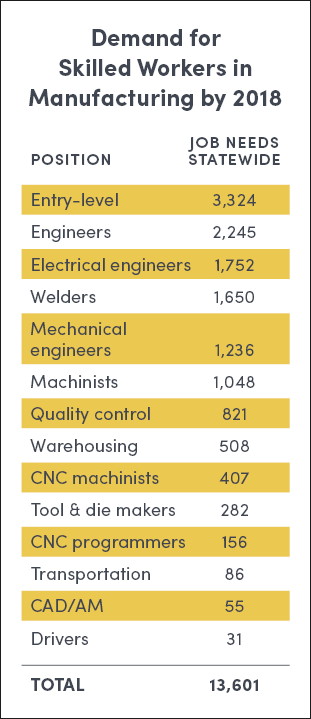Solving State’s Workforce Challenges Demands Focus, Collaboration

Amazon’s recent decision to drop Connecticut from its list of potential second headquarters locations was disappointing, but not completely unexpected.
As companies expand, they look for business-friendly climates to be sure, but their primary focus is the availability of talent at every level.

Source: 2017 Survey of Connecticut Manufacturing Workforce Needs.
The reason? Simply put, talent at every level is not what Connecticut has to offer.
According to the National Skills Coalition, 48% of all jobs in the state are considered middle-skill, and the demand for middle-skill jobs is expected to remain strong through at least the next five years.
Most telling is that the state’s supply of high-skill and lower-skill workers exceeds demand, while the reverse is true for middle-skill workers.
Middle-skill jobs generally require some significant education and training beyond high school, but less than a bachelor’s degree—including associate’s degrees, vocational certificates, and on-the-job training (i.e., apprenticeships).
This is particularly true for sectors such as manufacturing, a fact that has proven itself in the desperate search by employers of all sizes for such positions as machinists and welders.
Solving the Jobs Problem
As Connecticut industries scramble to fill positions, government, philanthropic, and nonprofit entities are feverishly working to meet demand and close the gap between job seekers and employers.
This is a good thing. But to work, collaboration, committed employer engagement, and a framework for evaluating results are critical if the state is to solve its jobs problem.
A recent Gallup study reveals that while 96% of academic officers believe students are being properly prepared for the world of work, only 11% of employers agree.
This is a telling awareness gap that needs to be closed by linking employers to training programs and strengthening apprenticeship initiatives, both components of a cohesive workforce development strategy.
Last year, General Dynamics Electric Boat revived its apprenticeship program with the support of a $5 million federal grant.
In the face of limited resources, some turn to competition rather than collaboration. This is no time for turf battles.
EB's secret to success?
They collaborated with Three Rivers Community College and the Eastern Advanced Manufacturing Alliance to offer customized programs for eligible students through the Eastern Connecticut Manufacturing Pipeline Initiative.
Developed to address the massive need for skilled workers at EB and EAMA companies, the short-term (six-to-eight weeks) training programs are available to unemployed and underemployed workers.
In the face of limited resources, some organizations may turn to competition rather than collaboration. But this is no time for turf battles.
Collaboration, Robust Business Engagement
Just as public workforce systems cannot operate effectively with disconnected programs—a strong argument for aligning workforce and economic development initiatives through legislation—entities that fail to collaborate prevent stronger efforts from taking shape, and limit systemic ability to be nimble in addressing employer needs.
The concept of "If we build it, they will come," is misguided.
Employers must be at the table. As the EB model demonstrates, addressing industry's workforce needs can only truly occur with collaboration and robust employer engagement.
Models such as the National Academy Foundation allow businesses to shape the future workforce by enhancing the high school learning environment to include industry-specific STEM curriculum and work-based learning experiences such as internships.
It's not only disconnected workforce development programs sapping Connecticut of our potential. The use of different performance measures results in disjointed accountability, further limiting results.
Federal regulations require the state to report on its program results and outcomes regarding employability. But many programs are funded through sources other than the Workforce Innovation and Opportunity Act, and the employment outcomes for participants are far harder to determine.
How Connecticut Wins
Now is the time to figure this out.
Connecticut finished 2017 with an encouraging glimmer of hope on the jobs front, posting 7,700 new jobs for the year—4,100 of which were new manufacturing jobs.
To build on this trend, Connecticut must commit to a comprehensive plan, one that requires coordination, collaboration, and a common yardstick to measure progress.
A universal evaluation framework for workforce development efforts will allow industry to more easily wade through the plethora of services and will ensure resources are being utilized effectively.
Connecticut's workforce viability relies on its ability to establish a system that meets immediate and future employer needs.
That system can only be developed working together, sharing best practices, and committing to accountability.
That's how Connecticut—and all its residents—win.

RELATED
EXPLORE BY CATEGORY
Stay Connected with CBIA News Digests
The latest news and information delivered directly to your inbox.


